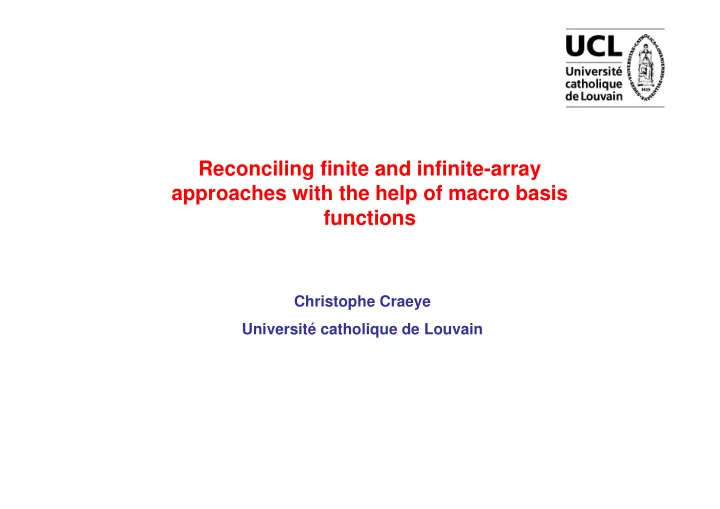

Reconciling finite and infinite-array approaches with the help of macro basis functions Christophe Craeye Université catholique de Louvain
Goals Tackle medium-to-large size arrays of complex elements with high accuracy, while exploiting as much as possible infinite-array results. Get solutions from periodic as well as non periodic excitation whole impedance matrix and all embedded element patterns Consider extreme cases with electrically connected elements and with anomalies MBF approach with special choice of MBFs
Wave phenomenology in finite arrays Finite-by-infinite array port currents Generated by single Reflected by Reflected by source in periodic array ends array ends structure ~ same distributions as forward wave, except for edge elements
Brute infinite-array solution Finite-by-infinite array Brute truncation of infinite-array current distributions: • scattering by edges is omitted • parasitic contributions from complementary arrays • limited to periodic excitation
Windowing 1 method Finite-by-infinite array Reflected by Reflection by array ends: array ends not accounted for Array pattern= « active » element pattern (infinite array) x array factor A. Roederer, ``Etude des réseaux finis de guides rectangulaires à parois épaisses,'' L'onde Electrique , vol. 51, pp. 854-861, Nov. 1971 .
Windowing 2 method Finite-by-infinite array Finite-array Green’s function: Solve for this element Assuming others have same current distribution X window factor w Finite Infinite Window w A.K. Skrivervik and J.R. Mosig, Analysis of finite phased arrays of microstrip patches, IEEE Trans. Antennas Propagat., vol. 41, pp. 1105-1114, Aug. 1993.
Wave phenomenology in finite arrays Finite-by-infinite array port currents Generated by single Reflected by Reflected by source in periodic array ends array ends structure ~ same distributions as forward wave, except for edge elements
Array Scanning Method with finite resolution (B. Munk et al., 1979) Current at ant. m Infinite-array solution for phase for ant. 0 excited shift � between elements Aliasing: Repetition of source every N elements
Array Scanning Method with finite resolution Finite-by-infinite array Reflected by Generated by single Reflected by array ends source in periodic structure array ends Aliased through discrete array scanning method
Macro Basis Function approach Current distribution = superposition of distributions obtained in small problems e.g. a single antenna with « a whole spectrum » of excitations Problem with connected elements: edge currents Possible solution: extend the element somewhat (cf. Maaskant et Mittra) and/or introduce some resistive tapering at the edges.
Macro Basis Function approach Isolated element Use ASM solutions as MBF’s � � ! � � Elt 1 Elt 2 Elt 4 Elt 8 C. Craeye and R. Sarkis, Finite array analysis through combination of Macro Basis Functions and Array Scanning methods, ACES Journal, April 2008.
Macro Basis Function approach Use ASM solutions as MBF’s � � � ! � ASM solutions: linear combinations of infinite- array solutions Use infinite-array solutions ! Requirement: regularly distributed in reciprocal space ( � � � � space)
Macro Basis Function approach � y � invisible space �� b ������ �� �� �� ������ ������ ������ visible space �� � � x �� a ������ �� �� �� ������ ������ ������ �� Requirement: regularly distributed in reciprocal space ( � � space) � �
Add edge current distributions 2X2 array simulations add 8 independent current distributions NB: can be reduced to single cell problem through symmetry
Numerical results for a 5X5 array E-plane pattern 50 dB !!! error Embedded element pattern for corner element at 1 GHz 12.7 cm
Current distribution in « tough » truncation case � =60, corner Error for 2X2 ASM Error for 4X4 ASM element, for center element excited
Port currents at 500 MHz « exact » for 3 different excitations -50 -50 dB -100 -100 -150 errors MBFs from 2X2 ASM MBFs from 4X4 ASM
Analysis of anomalies � y � �� b ������ �� �� �� ������ ������ ������ �� � x �� a ������ �� �� �� ������ ������ ������ �� Singularities lead to slowly decaying current distributions. Also captured in spectral ( � x, � y ) domain.
Analysis of anomalies 1 GHz 1.56 GHz anomalous 1.56 GHz, eigenvector with currents near broadside lowest eigenvalue
Active reflection coefficient in reciprocal space � x � y
Analysis of anomalies 5x5 array with first element excited at 1.56 GHz Port current « exact » Error N=2 Error N=4 Error N=6 Element index
Analysis of anomalies • We reviewed several methods for finite arrays involving infinite-array results. • A key quantity is the current distribution generated by on element in an infinite array. Can be computed with the ASM • To avoid assumptions made in windowing methods, MBF’s are extracted from ASM solutions. • Dramatic improvement of the solution with increasing order of ASM. • Also allows analysis in case of eignmodes, as soon as they can be detected in the reciprocal domain.
Recommend
More recommend